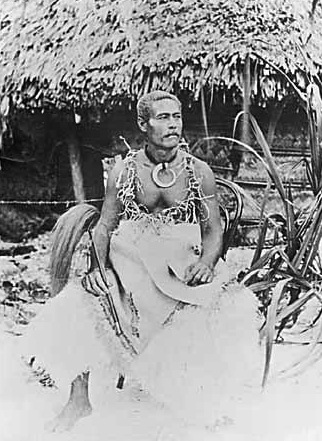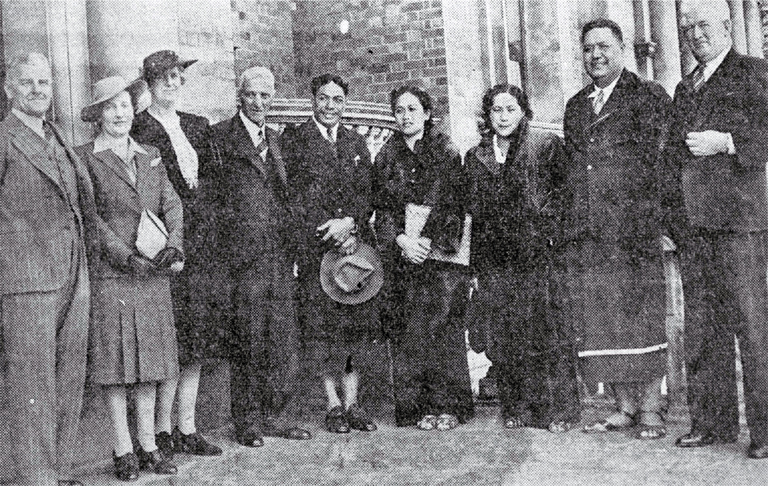|
Tupua Tamasese
Tupua (known as Tupua Tamasese) is a state dynasty and one of the four paramount chiefly titles of Samoa, known as the Tama-a-Aiga or 'Sons of the Great Families'). It is the titular head of one of Samoa's two great royal families - Sā Tupua, the lineage of Queen Salamasina. The 'Tupua' refers to Salamasina's descendant, King Tupua Fuiavailili, who was the first to unite both of Salamasina's descent lines in his personage and ascended to the Kingship of Samoa in c.1550, upon the death of his adoptive father, King Muagututi'a. Tupua Fuiavailili was adopted by his aunt, Fenunu'ivao (daughter of Leutele and wife of King Muagututi'a) and named as the King's successor. Tupua's rise also led to the first usage of the term "Tama-a-'aiga" by the orator polity of Leulumoega and Lufilufi, in reference to his many genealogical connections to the great families of Ātua. The 'Tamasese' part refers to his descendant Tupua Tamasese Titimaea, whose prowess in battle and generosity won favour wi ... [...More Info...] [...Related Items...] OR: [Wikipedia] [Google] [Baidu] |
Tupua Tamasese Lealofi III
Tupua Tamasese Lealofi-o-ā'ana III (4 May 1901 – 29 December 1929) was a paramount chief of Samoa, holder of the Tupua Tamasese dynastic title and became the leader of the country's pro-independence Mau movement from early 1928 until his assassination by New Zealand police in 1929. Inspired by his Christian beliefs, traditional customs and culture of Samoa, Lealofi III became one of the first leaders of the 20th century to employ nonviolent resistance against colonial rule which laid the foundations for Samoa's successful campaign for independence, which it attained in 1962. He was fatally shot by New Zealand police during a peaceful Mau procession in Apia on 28 December 1929, in what became known as Black Saturday. Mau movement In 1924 Tamasese was banished to Savai'i by Administrator George Spafford Richardson for failing to remove a hibiscus hedge from his land. When he returned to inquire about the length of his banishment, he was imprisoned, deprived of his title, an ... [...More Info...] [...Related Items...] OR: [Wikipedia] [Google] [Baidu] |
Tupua Tamasese Lealofi IV
Tui Ātua Tupua Tamasese Lealofi IV (8 May 1922 – 9 July 1983) was the second prime minister of Samoa from 25 February 1970 to 20 March 1973 and again from 21 May 1975 to 24 March 1976. He held the title of Tupua Tamasese, one of the four main chiefly titles of Samoa (the Tama-a-Aiga) from 1965 until his death in 1983. Biography Lealofi was born in Apia in May 1922, the eldest son of Mau movement leader Tupua Tamasese Lealofi III, who was killed by New Zealand Police in 1929.Tupua Tamases Lealofi IV ''Pacific Islands Monthly'', September 1983, p65 After studying at the Marist Brothers school and Malifa high school, he attended the Fiji School of Medicine ...
[...More Info...] [...Related Items...] OR: [Wikipedia] [Google] [Baidu] |
Tui Manu'a
The title Tui Manuʻa was the title of the ruler or paramount chief of the Manuʻa Islands in present-day American Samoa. The Tuʻi Manuʻa Confederacy, or Samoan Empire, are descriptions sometimes given to Samoan expansionism and projected hegemony in Oceania which began with the founding of the Tui Manu'a Title, Traditional oral literature of Samoa and Manu'a talks of a widespread Polynesian network or confederacy (or "empire") History The Tui Manu'a is the oldest title in Ancient Samoa. According to Samoan and Tongan oral histories, the first Tui Manu'a was a direct descendant of the Samoan supreme god, Tagaloa. In Samoan lore, the islands of Manu'a (Ofu, Olosega, and Ta'u) are always the first lands to be created or drawn from the sea; consequently the Tui Manu'a is the first human ruler mentioned. This "senior" ranking of the Tui Manu'a title continues to be esteemed and acknowledged by Samoans despite the fact that the title itself has not been occupied since the A ... [...More Info...] [...Related Items...] OR: [Wikipedia] [Google] [Baidu] |
Tuimaleali'ifano
Tuimaleali'ifano is one of the four paramount chiefly titles of Samoa, known as the ''Tama-a-Aiga'' ("Sons of the Families"). Samoa's other three paramount chiefs are Malietoa, Mata'afa and Tupua Tamasese. The seat of the Tuimaleali'ifano title is at Falelatai in the Aʻana district. The current title-holder is Tuimaleali'ifano Va'aletoa Sualauvi II, who has held the title since 1977 and currently serves as ''O le Ao o le Malo'' (head of state). Origins The title is the most recent of the ''Tama-a-Aiga'', originating in the mid-nineteenth century with Tuiaana Sualauvi, a nephew of Malietoa Fitisemanu I. Sualauvi was appointed ''Tui A'ana'' in 1848. By the early 1860s he had also been appointed to the pāpā titles of Gatoaitele and Vaetamasoalii. In 1869, he obtained the support of Fuataga and Tafua of Aleipata and Moeono and Tusa of Falefa and Lufilufi and was appointed ''Tui Atua'', briefly ascending to the position of ''Tupu Tafa-ifa''. His reign however, would only last a ... [...More Info...] [...Related Items...] OR: [Wikipedia] [Google] [Baidu] |
Malietoa
Mālietoa ( ''Mālietoa'') is a state dynasty and one of the four paramount chiefly titles of Samoa. It is the titular head of one of the two great royal families of Samoa: Sā Malietoa. Literally translated as "great warrior", the title's origin comes from the final words of the Tongan warriors as they were fleeing on the beach to their boats, "Malie To`a, Malo e tau..." ("Great warrior, thank you for the war). The title is currently held by His Highness Malietoa Fa’amausili Molī, who was bestowed the honor in Malie on 16 August 2018, ascending to the title after the death of his father, His Highness Malietoa Tanumafili II on 11 May 2007. History In early Polynesian history Tongan king Tu'i Tonga Talakaifaiki of the Tu'i Tonga dynasty ruled, around 1250 to 1300, over several western Polynesian polities including Lau group of islands (eastern Fiji), Niue, 'Uvea, Futuna, 'Upolu, and Savai'i). Tu'i Tonga Talakaifaiki established a long-term residence at Safotu, Savai'i, Sa ... [...More Info...] [...Related Items...] OR: [Wikipedia] [Google] [Baidu] |
Malietoa Tanumafili I
Susuga Malietoa Tanumafili I (1879 – 5 July 1939) was the Malietoa in Samoa from 1898 until his death in 1939. Personal and political life Tanumafili was born in 1880 to Malietoa Laupepa and Sisavai‘i Malupo Niuva‘ai. He attended the London Missionary College in Malua, before continuing his education in Fiji.Last King of Samoa ''Pacific Islands Monthly'', August 1939, p29 He married Momoe Lupeuluiva Meleiseā and had five children: Sisavai‘i Lupeuluiva, Vaimo‘oi'a, Salamāsina, Tanumafili II, and Sāveaali‘i Ioane Viliamu. When his father died in 1898, Tanumafili was declared "King of Samoa" (Tafa'ifa) by , and recognised by ... [...More Info...] [...Related Items...] OR: [Wikipedia] [Google] [Baidu] |
Heads Of State Of Samoa
The ''O le Ao o le Malo'' ( Samoan for "Head of State") is the head of state of Samoa. The position is described in Part III of the 1960 Samoan constitution. At the time the constitution was adopted, it was anticipated that future heads of state would be chosen from among the four ''Tama a 'Aiga'' "matai" paramount chiefs in line with customary protocol. This is not a constitutional requirement, so Samoa can be considered a parliamentary republic rather than a constitutional monarchy. The government Press Secretariat describes Head of State as a "ceremonial president". The holder is given the formal style of ''Highness'', as are the heads of the four paramount chiefly dynasties. Members of the Council of Deputies act as deputy heads of state, standing in for the head of state when they are unable to fulfil their duties. The current O le Ao o le Malo is Tuimalealiʻifano Vaʻaletoʻa Sualauvi II, who was elected to a five-year term which started on 21 July 2017. Tuimalealiʻi ... [...More Info...] [...Related Items...] OR: [Wikipedia] [Google] [Baidu] |
Prime Minister Of Samoa
The prime minister of the Independent State of Samoa ( sm, Palemia o le Malo Tuto’atasi o Sāmoa) is the head of government of Samoa. The prime minister is a member of the Legislative Assembly, and is appointed by the O le Ao o le Malo (Head of State) for a five-year term. Since independence in 1962, a total of seven individuals have served as prime minister. The incumbent was disputed due to the 2021 constitutional crisis, when Tuila'epa Sa'ilele Malielegaoi refused to accept the results of the 2021 general election. On 23 July 2021, the Samoan Court of Appeal ruled that the Faʻatuatua i le Atua Samoa ua Tasi (FAST) party had been in government since 24 May. Tuila'epa then conceded defeat, resulting in FAST party leader Fiamē Naomi Mataʻafa becoming prime minister. History of the office Colonial period The first prime minister during the colonial period was Albert Barnes Steinberger, who originally represented the American government in the Samoan Islands but w ... [...More Info...] [...Related Items...] OR: [Wikipedia] [Google] [Baidu] |
Tupua Tamasese Meaʻole
Tupua Tamasese Mea'ole (3 June 1905 – 5 April 1963) was a Western Samoan paramount chief. He held the royal title of Tupua Tamasese from 1929 to 1963, and O le Ao o le Malo (Head of State) jointly with Malietoa Tanumafili II from 1962 until his death the following year. Biography He was born in Vaimoso 1905 as the one of three sons of the paramount chief Tupua Tamasese Lealofi II. He was educated at the Marist school in Apia.Tamasese: Architect of West Samoan Independence ''Pacific Islands Monthly'', May 1963, pp41–47 In 1929, he was installed as Tupua Tamasese when his elder brother and Mau leader, |
Mau Movement
The Mau was a non-violent movement for Samoan independence from colonial rule during the first half of the 20th century. ''Mau'' means ‘resolute’ or ‘resolved’ in the sense of ‘opinion’, ‘unwavering’, ‘to be decided’, or ‘testimony’; also denoting ‘firm strength’ in Samoan. The motto for the Mau were the words Samoa mo Samoa (Samoa for the Samoans). Similarly in Hawaiian ''Mau'' means to strive or persevere, and is often linked with Hawaiian poetry relating to independence and sovereignty struggles. The movement had its beginnings on the island of Savai'i with the ''Mau a Pule'' resistance in the early 1900s with widespread support throughout the country by the late 1920s. As the movement grew, leadership came under the country's chiefly elite, the customary '' matai'' leaders entrenched in Samoan tradition and fa'a Samoa. The Mau included women who supported the national organisation through leadership and organisation as well as taking part ... [...More Info...] [...Related Items...] OR: [Wikipedia] [Google] [Baidu] |





.jpg)


